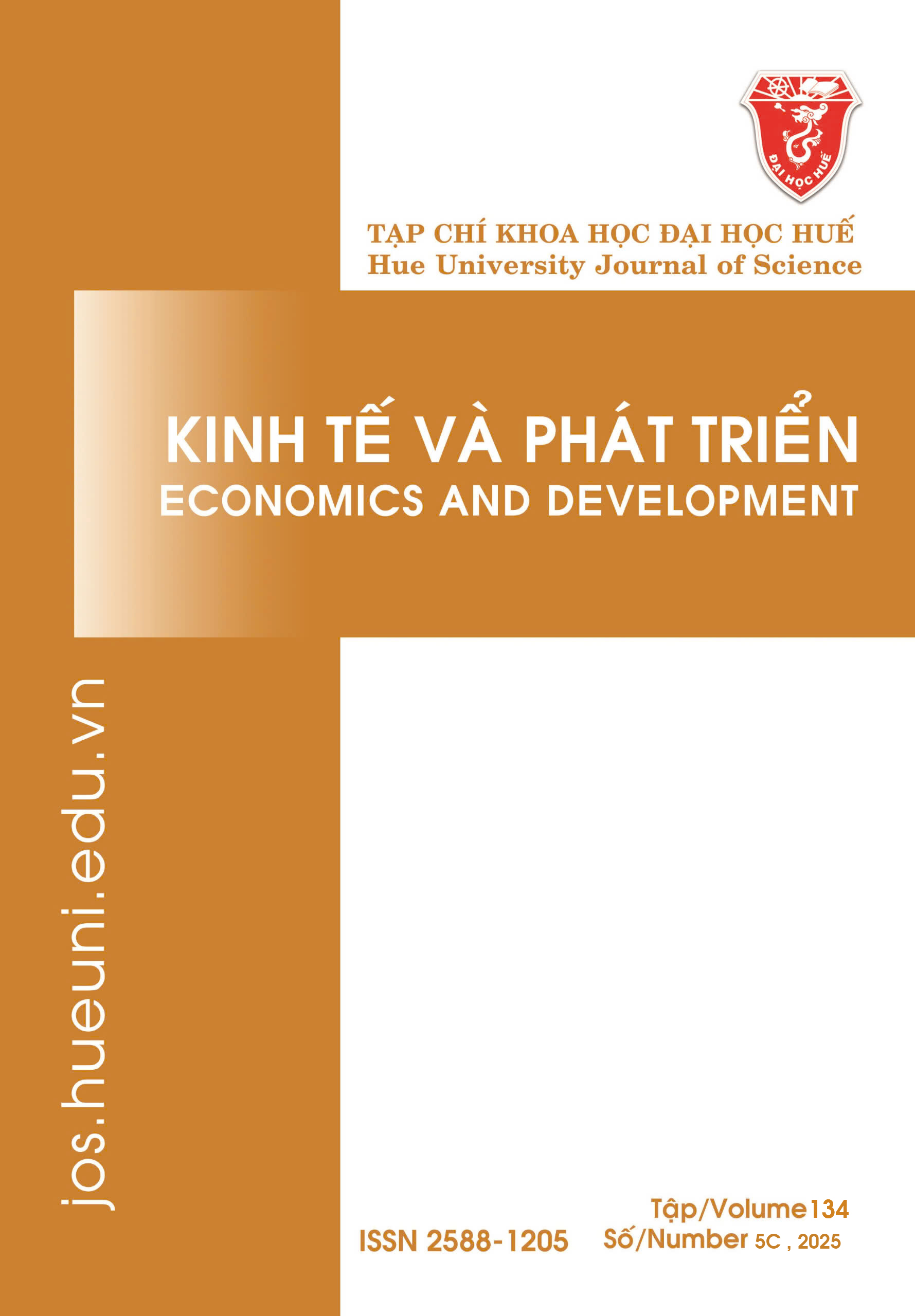Tóm tắt
Nghiên cứu này đánh giá tác động của việc thực hành quy tắc 3R (Giảm thiểu – Tái sử dụng – Tái chế) đến hiệu quả phát triển bền vững của các doanh nghiệp F&B tại thành phố Huế, trong bối cảnh địa phương đang thúc đẩy chuyển đổi sang mô hình kinh tế tuần hoàn. Dữ liệu được thu thập từ 220 doanh nghiệp đại diện ba phân khúc dịch vụ ăn uống, sử dụng phương pháp phân tích nhân tố khẳng định (CFA) và mô hình cấu trúc tuyến tính (SEM). Kết quả cho thấy thực hành 3R có ảnh hưởng tích cực đến cả ba khía cạnh của phát triển bền vững: hiệu quả kinh tế, hiệu quả môi trường và hiệu quả xã hội. Trong đó, tác động đến yếu tố môi trường là mạnh nhất, tiếp theo là xã hội và kinh tế. Những phát hiện này củng cố luận điểm rằng 3R không chỉ mang lại lợi ích môi trường mà còn là công cụ chiến lược giúp nâng cao hiệu quả vận hành và uy tín thương hiệu của doanh nghiệp. Nghiên cứu đề xuất một số hàm ý chính sách nhằm thúc đẩy hành vi 3R, bao gồm hỗ trợ tài chính, đào tạo chuyên sâu, nâng cấp hạ tầng tái chế và xây dựng hệ thống đánh giá hiệu quả 3R trong doanh nghiệp.
Tài liệu tham khảo
- K. Capital (2024), Báo cáo ngành Food & Beverage Việt Nam.
- FAO (2011), Global Food losses and Food waste, [Online]. Available: http://www.unep.org/wed/2013/ quickfacts.
- J. D. azimi Jibril, I. Bin Sipan, M. Sapri, S. A. Shika, M. Isa, and S. Abdullah (2012), 3Rs Critical Success Factor in Solid Waste Management System for Higher Educational Institutions, Procedia - Social and Behavioral Sciences, 65, ICIBSoS, 626–631, doi: 10.1016/j.sbspro.2012.11.175.
- M. Immanuel, R. Hartopo, S. P. Anantadjaya, and T. Saroso (2013), Food Waste Management: 3R Approach in Selected Family-Owned Restaurants, 02, 01, [Online]. Available: http://papers.ssrn.com/abstract=2280928.
- M. Ahmadi (2017), Evaluating the Performance of 3Rs Waste Practices: Case Study-Region One Municipality of Tehran, Advances in Recycling and Waste Management, 02, 02, doi: 10.4172/2475-7675.1000130.
- E. Papargyropoulou, R. Lozano, J. K. Steinberger, N. Wright, and Z. Bin Ujang (2014), The food waste hierarchy as a framework for the management of food surplus and food waste, Journal of Cleaner Production, 76, 106–115, doi: 10.1016/j.jclepro.2014.04.020.
- M. E. Pratarelli and G. Mainguy (2010), Surveys and Perspectives Integrating Environment and Society Social Pressure and Recycling: A Brief Review, Commentary and Extensions, OpenEdition Journals, 03, 01, 1–10.
- G. Allen (2020), “The 3Rs: Reduce, Reuse, Recycle,” https://www.fmtn.org/Blog.aspx?IID=21.
- N. Haluzan (2009), How Does Global Warming Affect Animals?.
- M. J. Epstein and M. J. Roy (2024), Making the business case for sustainability: Linking social and environmental actions to financial performance, J. Corp. Citizsh., 09, 79–96, doi: 10.9774/gleaf.4700.2011.su.00008.
- T. Katz-Gerro and J. López Sintas (2019), Mapping circular economy activities in the European Union: Patterns of implementation and their correlates in small and medium-sized enterprises, Business Strategy and The Environment, 28, 04, 485–496, doi: https://doi.org/10.1002/bse.2259.
- S. Harris, M. Martin, and D. Diener (2021), Circularity for circularity’s sake? Scoping review of assessment methods for environmental performance in the circular economy, Sustainable Production and Consumption, 26, 172–186, doi: https://doi.org/10.1016/j.spc.2020.09.018.
- H. N. Nguyen and S. Mohamed (2011), Leadership behaviors, organizational culture and knowledge management practices: An empirical investigation, Journal of Management Development, 30, 02, 206–221, doi: 10.1108/02621711111105786.
- S. Sauvé, S. Bernard, and P. Sloan (2016), Environmental sciences, sustainable development and circular economy: Alternative concepts for trans-disciplinary research, Environmental Development, 17, 48–56, doi: https://doi.org/10.1016/j.envdev.2015.09.002.
- P. K. Dey, C. Malesios, S. Chowdhury, K. Saha, P. Budhwar, and D. De (2022), Adoption of circular economy practices in small and medium-sized enterprises: Evidence from Europe, Internatioal Journal of Production Economics, 248, February, 108496, doi: 10.1016/j.ijpe.2022.108496.
- O. Rodríguez-Espíndola et al.(2022), The role of circular economy principles and sustainable-oriented innovation to enhance social, economic and environmental performance: Evidence from Mexican SMEs, Internatioal Journal of Production Economics, 248, February, 108495, doi: 10.1016/j.ijpe.2022.108495.
- S. Chowdhury et al. (2022), Impact of Organisational Factors on the Circular Economy Practices and Sustainable Performance of Small and Medium-sized Enterprises in Vietnam,” Journal of Business Research, 147, 362–378, doi: 10.1016/j.jbusres.2022.03.077.
- J. F. Hair, R. E. Anderson, R. L. Tatham, and C. William (1998), Black (1998), Multivariate data analysis, Upper Saddle River, NJ: Prentice Hall.
- J. F. Hair (2021), Partial Least Squares Structural Equation Modeling (PLS-SEM) Using R, Classroom Companion: Business.
- B. M. Byrne (2013), Structural equation modeling with Mplus: Basic concepts, applications, and programming, Routledge.
- K. A. Bollen (1989), Structural equations with latent variables., John Wiley & Sons.
- C. Fornell and D. F. Larcker (1981), Structural equation models with unobservable variables and measurement error: Algebra and statistics, Sage publications Sage CA: Los Angeles, CA.
- M.-F. Chen (2016), Extending the theory of planned behavior model to explain people’s energy savings and carbon reduction behavioral intentions to mitigate climate change in Taiwan–moral obligation matters, Journal of Cleaner Production, 112, 1746–1753.
- B. Zhang, S. Yang and J. Bi (2013), Enterprises’ willingness to adopt/develop cleaner production technologies: an empirical study in Changshu, China, Journal of Cleaner Production, 40, 62–70, doi: https://doi.org/10.1016/j.jclepro.2010.12.009.
- D. Hooper, J. Coughlan, and M. R. Mullen (2008), Structural Equation Modelling: Guidelines for Determining Model Fit, Electron. J. Bus. Res. Methods, 06, 01, 53–60.
- P. M. Bentler (1990), Comparative fit indexes in structural models, Psychological Bulletin, 107, 02, 238–246.
- M. W. Browne and R. Cudeck (1993), Alternative ways of assessing model fit, Testing Structural Equation Models, K. A. Boll., 136–162.
- Y. Cai et al. (2023), Enhancing SWAT model with modified method to improve Eco-hydrological simulation in arid region, Journal of Cleaner Production, 403, 136891, doi: https://doi.org/10.1016/j.jclepro.2023.136891.

công trình này được cấp phép theo Creative Commons Ghi công-Chia sẻ tương tự 4.0 License International .
Bản quyền (c) 2025 Array
